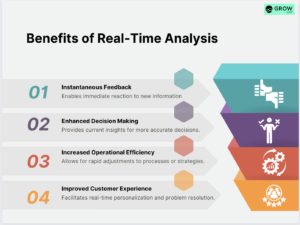
Diversifying Revenue Streams
One the revenue growth strategies for success is to diversify revenue streams. This ensures businesses are not entirely dependent on a single income source, which can be risky. For instance, companies can explore various income sources such as new products, services, or subscription models. This tactic allows businesses to become more resilient and maximize growth. Companies that diversify their revenue streams often mitigate risks better and can decouple profitability from a single market.
According to Forbes, diversifying businesses are better equipped to face economic fluctuations. By creating multiple financial pillars, companies support their long-term goals and reduce economic vulnerability.
Automating Business Processes
Efficiency and resource optimization significantly enhance business profitability. Automation is key to achieving these goals. By automating routine tasks, businesses save time and reduce errors. Automation covers various operations, from Customer Relationship Management (CRM) for customer management to automated marketing platforms.
For instance, CRM systems help manage customer relationships more effectively, allowing employees to focus on higher-value tasks. As noted by McKinsey, automation is a catalyst for innovation. It drives companies to adapt continually and improve efficiency, leading to significant cost savings and productivity enhancement.
Leveraging Customer Feedback
Customer feedback is invaluable for guiding product and service improvements. Implementing feedback loops through surveys, review platforms, or direct interactions helps businesses stay in tune with consumer needs. Acting on feedback enhances customer satisfaction and loyalty, boosting profitability, and fostering a loyal client base.
For instance, tech giants use beta testers to refine software before mass release. Regular feedback ensures products or services remain relevant and meet customer expectations. Additionally, leveraging feedback allows businesses to identify pain points and areas for improvement, enabling innovation and responsiveness to market changes.
Building Strategic Partnerships
Collaborations with other businesses can create mutually beneficial opportunities and open new revenue streams. Strategic partnerships allow businesses to leverage each other’s strengths and explore new markets. A practical example is a tech company partnering with a logistics firm to enhance service delivery.
Effective partnerships provide synergies such as shared resources and market access. Such collaborations can open new growth avenues that may have been previously inaccessible. Through combined marketing efforts, businesses can expand reach and visibility, accelerating growth and driving profitability.
Embracing Technology and Innovation
Keeping up with technological advancements is crucial for staying competitive. Adopting new technologies can streamline operations and improve offerings. From digital marketing enhancements to data analytics, leveraging technology is vital for driving profitability and innovation. Businesses that embrace technology can quickly respond to market changes and consumer demands.
For example, many companies now use data analytics tools to gain insights into customer behavior, aiding targeted marketing and product development. Staying updated with technological advancements ensures businesses remain agile and maintain a competitive edge through continuous improvement and innovation.
Investing in Employee Development
Your workforce is a pivotal asset. Investing in training and career growth opportunities enhances productivity and fosters employee satisfaction. A well-trained team is more efficient and innovative, driving the company towards its goals. Providing continuous learning opportunities boosts morale and retention.
Companies offering regular training programs and educational incentives see increased retention and job satisfaction. Employees feel valued and motivated to contribute to the company’s success. Investing in employee development also brings new skills and perspectives, fostering a culture of creativity and problem-solving.
Implementing Sustainable Practices
Incorporating sustainability into business operations is increasingly beneficial. Sustainable practices reduce environmental impact, result in cost savings, and improve brand reputation. Reducing energy consumption and using eco-friendly materials attract eco-conscious consumers and employees.
Moreover, sustainable practices can attract customers who prioritize environmental responsibility, offering long-term profitability and brand loyalty. For instance, adopting renewable energy sources or zero-waste policies often leads to cost savings and innovation. Sustainable practices improve operational efficiency and foster a positive corporate image.
Conclusion
- Boosting business profitability involves numerous strategies. Businesses can achieve long-term success by diversifying revenue streams, leveraging customer feedback, embracing automation, and investing in employee development. Implementing sustainable practices and exploring strategic partnerships further enhance profitability. A holistic approach incorporating various strategies ensures businesses remain resilient, competitive, and adaptable.






